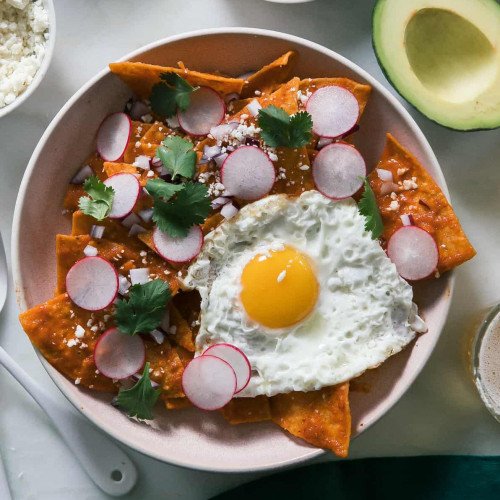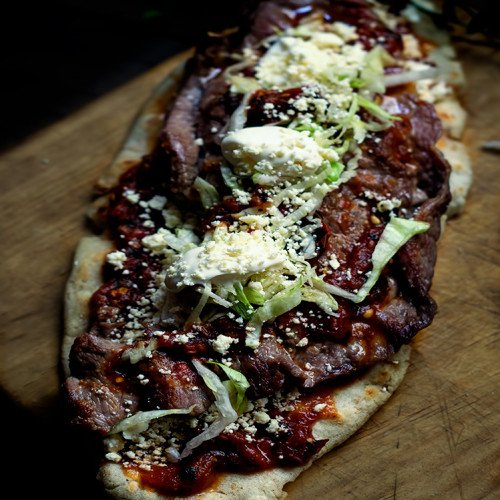Chilaquiles vs Huarache

Chilaquiles
Chilaquiles (Spanish pronunciation: [tʃilaˈkiles]) from the Nahuatl word chīlāquilitl [t͡ʃiːlaːˈkilit͡ɬ] ("chiles and greens") is a traditional Mexican breakfast dish consisting of corn tortillas cut into quarters and lightly fried. Typically, corn tortillas cut into quarters and lightly fried or baked for a lighter version are the basis of the dish.[2] Green or red salsa is poured over the crisp tortilla triangles. The mixture is simmered until the tortilla starts softening. Pulled chicken is sometimes added to the mix. It is commonly garnished with crema, crumbled queso fresco, sliced onion, and avocado slices. Chilaquiles can be served with refried beans, eggs (scrambled or fried) and guacamole as side dishes. As with many Mexican dishes, regional and family variations are quite common. Usually, chilaquiles are eaten at breakfast or brunch. This makes them a popular recipe to use leftover tortillas and salsas. In central Mexico, it is common for the tortilla chips to remain crisp. To achieve this, all ingredients except the salsa are placed on a plate and the salsa is poured at the last moment, seconds before serving. In Guadalajara, cazuelas are kept simmering filled with chilaquiles that become thick in texture, similar to polenta. In the state of Sinaloa, chilaquiles are sometimes prepared with cream. In the state of Tamaulipas, on the northeast side of the country, red tomato sauce is commonly used.
Statistics for this Xoptio

Huarache
Huarache (sometimes spelled guarache; [waˈɾatʃe] (About this soundlisten)) is a popular Mexican dish consisting of masa dough with smashed pinto beans placed in the center before it is given an oblong shape, fried masa base, with a variety of toppings including green or red salsa, onions, potato, cilantro and any manner of protein such as ground beef or tongue, and then finished with queso fresco.[1] Huaraches are also often paired with fried cactus leaves, or Nopales. This dish is most popular in its hometown of Mexico City and is also sold in cities with Mexican-American populations such as Los Angeles, Chicago, Minneapolis/St Paul, New York, San Francisco, San Antonio, Dallas/Fort Worth, and Houston, but have yet to become widely available across the entire United States.[2] Still, huaraches and other Mexican dishes have increased their presence in the Midwest due to increasing numbers of Latinos in rural America. The name "Huarache" is derived from the shape of the masa, similar to the popular sandals of the same name. The word Huarache is originally from Purépecha[3] and the Nahuatl word for huarache is kwarachi. Huaraches are similar to sopes and tlacoyos but differ in shape. Huaraches originated in Mexico City in about the early 1930s. Their origin was at a stall along La Viga navigation channel, where Mrs. Carmen Gomez Medina prepared tlacoyos.[4] When the navigation channel was covered to make the "Calzada de la Viga", Mrs. Gomez moved to another place and after 1957, when the Mercado de Jamaica was founded, she moved there, and then to a little place at Torno street. Because Mrs. Gomez's new invention was shaped differently than a sope or a tlacoyo, people started to call it "huarache".